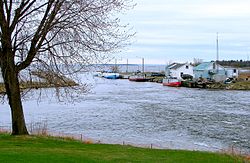Blind River, Ontario
Town of Blind River | |
|---|---|
Town | |
 The harbour on the North Channel in Blind River. | |
 | |
| Country | Canada |
| Province | Ontario |
| District | Algoma |
| Government | |
| • Type | Town |
| • Mayor | Bob Gallagher |
| • Governing Body | Blind River Town Council |
| • MP | Brent St. Denis (LPC) |
| • MPP | Mike Brown (OLP) |
| Area | |
| • Total | 520.59 km2 (201.00 sq mi) |
| Population (2006)[1] | |
| • Total | 3,780 |
| • Density | 7.3/km2 (19/sq mi) |
| Time zone | UTC-5 (EST) |
| • Summer (DST) | UTC-4 (EDT) |
| Area code | 705 |
| Website | Town of Blind River |
Blind River is a town situated on the North Channel of Lake Huron in the Algoma District, Ontario, Canada. The town was named after the nearby Blind River. Blind River celebrated its centennial in 2006.
History
French explorers discovered the North Channel and made it a renowned voyageur route. Fur traders, loggers and miners followed to seek natural resources. A fur trading post was established by the Northwest Company in 1789 at the mouth of the Mississagi River. When the fur trade slowed about 1820, the Hudson's Bay Company purchased the Northwest Company. A number of trappers settled along the rivers flowing into Lake Huron. One of these rivers, just three miles east of the Mississagi mouth, was called Penewobecong which translates to "smooth rock or sloping". The voyageurs named this river the Blind River because the mouth was not visible along the canoe route. The name Blind River was adopted by the settlement that grew at the mouth of the river.
The logging industry developed because of the accessibility of timber along the Blind River and Mississagi watersheds. The industry was spurred by a copper discovery in the mid 1800s in Bruce Mines. The first sawmill was built beside the mouth of the Blind River at the current site of the Old Mill Motel. The protected estuary of the east arm of the Blind River as well as the deep water offshore offered a good location for the mill. The sawmill provided timber and planks for the copper mine. By 1906 when Blind River had been incorporated as a town, a second larger sawmill had been erected on the west arm of the Blind River. Today the west arm is the location of the Blind River Marine Park. In 1929 the Carpenter Hixon Company built a state-of-the-art pine sawmill producing 89 million board feet of lumber in its first year. Through boom and bust the mill survived under the name McFadden Lumber Company for over forty years as the largest white pine sawmill east of the Rocky Mountains, with an annual capacity of 120,000,000 board feet (280,000 m³) of lumber (an output never reached in actual production.) The Great Mississauga Fire of 1948 led to a depletion of timber, difficult economic conditions and the eventual closing of the mill in 1969. The lumber history is commemorated in the Timber Village Museum.
In 1955 uranium was discovered near Blind River. The first uranium mine began operation as the Pronto mine in Algoma Mills. Although its life was short-lived, its significance was that it led to the discovery of the entire Blind River-Elliot Lake uranium mining camp. In 1983 a uranium refinery was built just west of Blind River. This uranium refinery is owned and operated by the Cameco Corporation which processes uranium concentrates from all over the world into uranium trioxide.
Population and economy
The town had a population of 3,780 in the Canada 2006 Census. Its main businesses are tourism, fishing, logging, and uranium refining. Transportation links are Highway 17 (part of the Trans-Canada Highway in Ontario), the Huron Central Railway operating on the leased Canadian Pacific Railway line that runs through the town, and the Blind River Marine Park, a town-owned marina servicing pleasure craft. The town also provides services to the surrounding communities through its District Health Centre, two high schools (W.C. Eaket Secondary School and École sécondaire catholique Jeunesse nord) and three elementary schools (Blind River Public School, St. Mary's Catholic Public School and École catholique St. Joseph). Blind River had 7 different churches, and Kingdom Hall located just out of the township, and a variety of merchants and service industries.
Blind River has many beaches on Lake Huron, including Fourth Sand, Sellers Park, Boom Camp, Forest Glen Beach, as well as many others.
Blind River is home to a large uranium refinery operated by the Cameco Corporation, which is situated just outside of town as well as a world renowned golf course by the name of Huron Pines Country Club.
Blind River is located at 46°11′N 82°57′W / 46.183°N 82.950°WInvalid arguments have been passed to the {{#coordinates:}} function.
Sports and culture
The town is home to the Blind River Beavers of the Northern Ontario Junior Hockey League.
Neil Young makes reference to Blind River in his song "Long May You Run".

